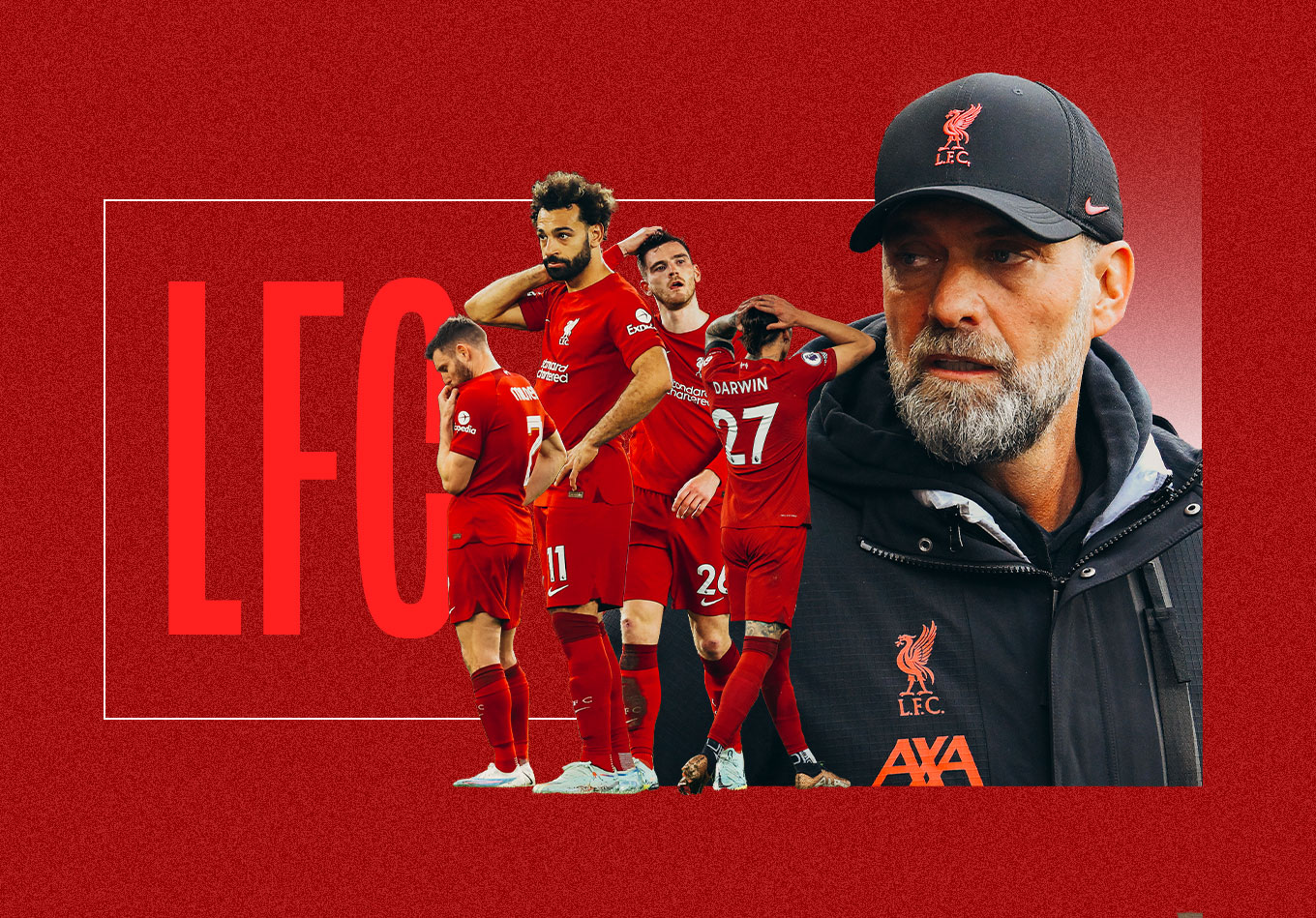Believe it or not, Liverpool have conceded more goals this season than they did throughout the entirety of the 2021-22 Premier League campaign.
The three goals shipped by the Reds against Wolves took their tally to 28, eclipsing the 26 of last year. It was the third time in their last four outings that Jurgen Klopp’s men had conceded three goals and they have now been breached on 11 occasions in their six Premier League outings since returning from their World Cup break. Twenty-eight goals conceded, by the way, is as many as 18th-place Everton, who they face next in the Merseyside derby on Monday night.
For a team that usually boasts one of the sternest defences in the English top-flight, this is unchartered territory.
The Reds conceded the fewest number of goals during the 2018-19 (22), 2019-20 (33) and 2021-22 (26) campaigns. At their current rate, they are on course to finish the season having been breached on 53 occasions, which would be a record high for a 38-game Premier League season.
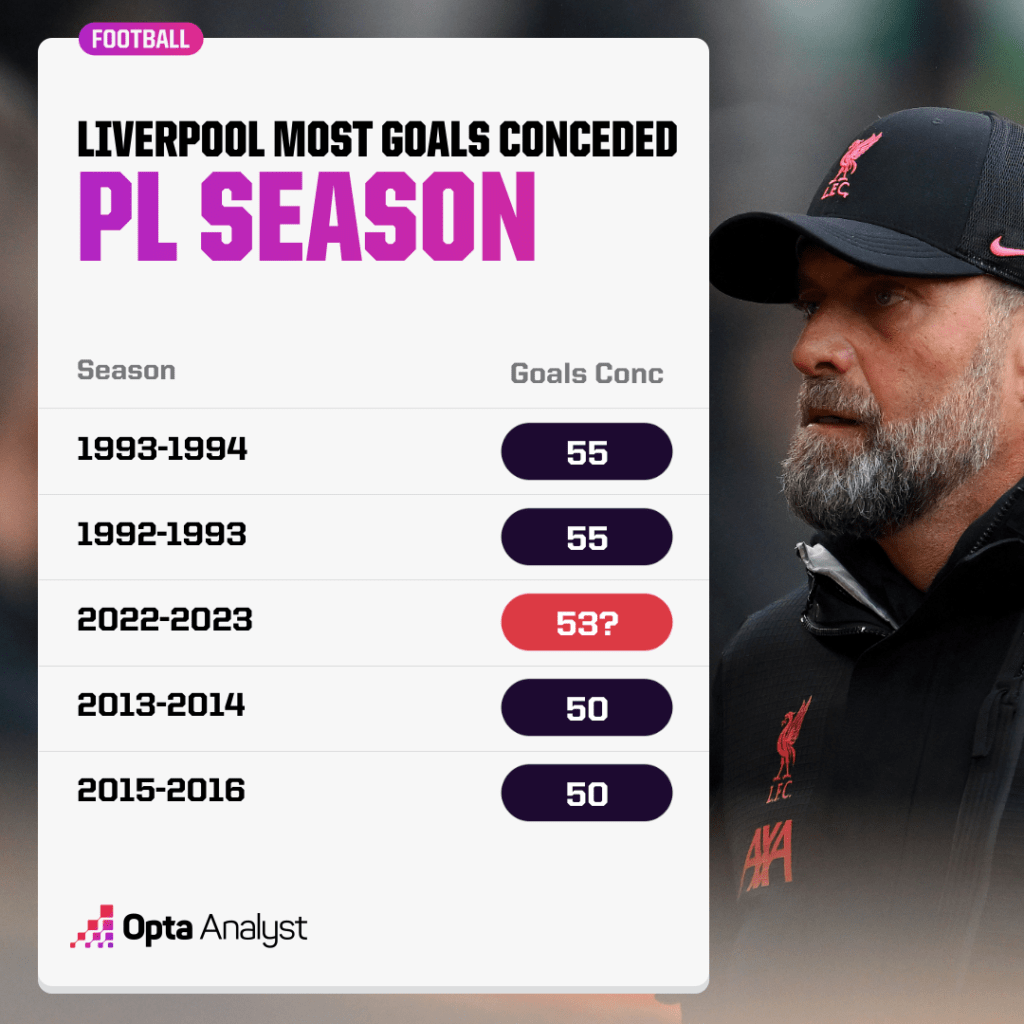
Liverpool’s current 1.4 goals against per game is their worst record in any Premier League season, and only six teams in 2022-23 currently have a poorer record. Three of them make up the bottom four.
This isn’t just a blip or a run of bad luck.
Liverpool top the big chances conceded per 90 chart, allowing 3.2. For a bit of context, this figure was 1.39 last season, a figure only four teams could better. As a consequence of this, the Reds have seen their non-penalty expected goals against average rise from 0.9 to 1.37 per game.
While only Chelsea (0.77) and Manchester City (0.63) limited the opposition more than the Reds during the 2021-22 campaign, now only seven teams have a higher non-penalty xG conceded average.
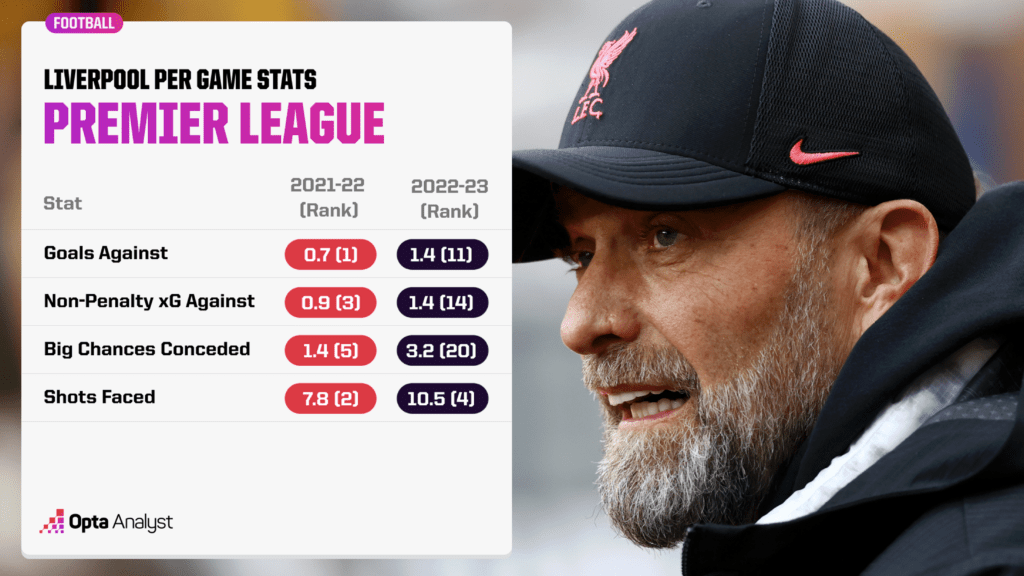
Perhaps surprisingly, the opposition had a non-penalty xG per shot average of 0.11 last term, the second-highest in the league. However, this does make sense. With Klopp’s side playing such a high defensive line, anyone who did manage to play through their press would have a better opportunity. Liverpool were aggressive without the ball last season too with their PPDA average of 9.9 the lowest of any team in the league.
This season, they allow the highest non-penalty xG per shot (0.13) and this is despite the fact they have adopted more of a mid-block press. The Reds have adopted a compact shape without the ball, have a PPDA average of 12 and opponents are stringing together 10+ pass sequences on 7.6 occasions per 90, up from 4.7. Even though Klopp’s men are looking to limit the threat of their opponents, they are actually conceding higher-value opportunities.
But, again, this does make sense.
Whereas in previous campaigns, Liverpool would be in control of the game – the ball, the space and, more often than not, the scoreline – this hasn’t been the case during the current campaign. Liverpool have conceded first in 60% of their Premier League matches and have been behind inside of five minutes in 25%.
Game state impacts everything.
Liverpool are chasing games for large periods and that makes it difficult to control key aspects of matches. The Reds have been forced to commit men forward and this means they are exposed during defensive transitions. They may be seeing a similar amount of the ball as in previous seasons (60% to 63% last year), but they aren’t truly in control. The 2019-20 Premier League champions went from dominating the ball by dominating the space to being allowed to have the ball while the opposition dictated where they could and couldn’t use it.
Now, opponents are biding their time and holding their shape before springing counter-attacks. With Liverpool’s new system, there’s a lot of space to hit.
As discussed in a previous feature, Klopp and his coaching team have been working on subtle changes to the way the Reds build and sustain attacks. The tweaks to midfield exposed that area of the pitch and are perhaps why goals were being conceded earlier on in the season.
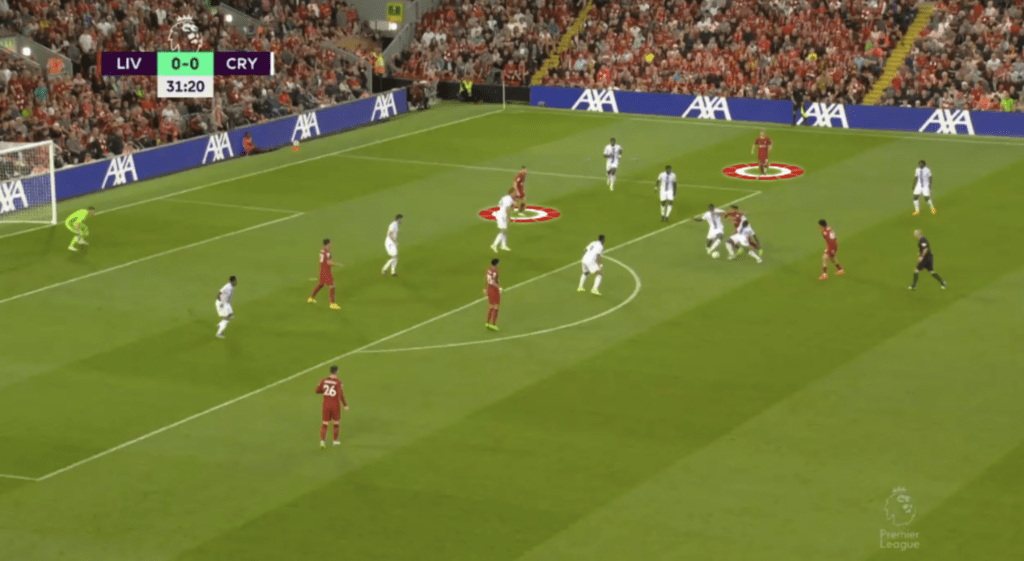
James Milner and Harvey Elliott are highlighted in the above screenshot. Those are two of the three midfielders named in the starting XI for the match against Crystal Palace and look where they are the Reds push for an opener.
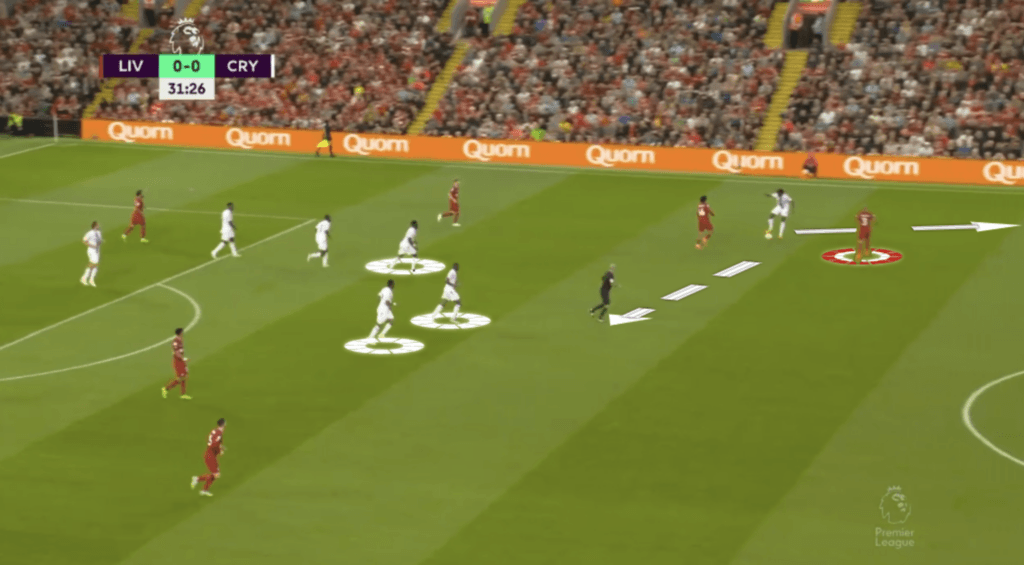
The away side manage to clear the ball and it falls nicely to Eberechi Eze. Now, having initially peeled into the space vacated by Trent Alexander-Arnold moving into a central area when Liverpool were in possession, Eze has multiple options. He could attack the space down the line or he could work the ball inside. Fabinho, highlighted in the picture, is in a tricky situation given if he blocks off the pass inside, the Palace man can just attack the space on the Liverpool right.
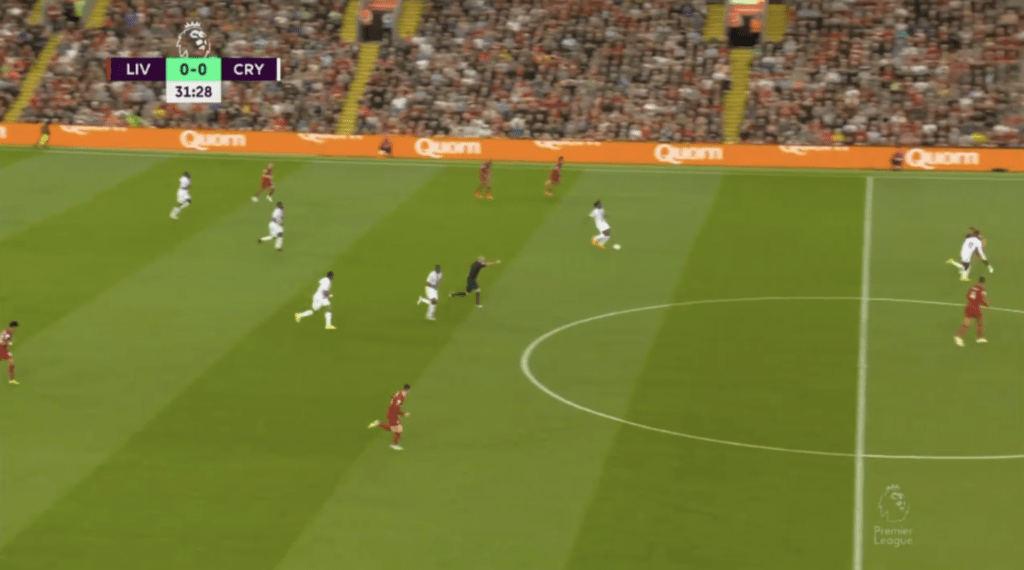
Fabinho tries to block Eze off, but the Palace winger shows quick feet to wriggle free and into the space. Even if he doesn’t look to play that pass to Wilfried Zaha, the former QPR youngster has team-mates supporting this counter in acres of space centrally.
This sort of thing kept happening with Liverpool committing bodies forward and leaving the deepest midfielder with a lot of space to cover. If he wasn’t quick enough, it was a clear route through to the backline.
The Reds kept conceding fairly straightforward chances with teams just running at their defence, no matter who the personnel were. That suggests an issue with tactics rather than the individuals.
In the search for compactness, Klopp has deployed a 4-4-2 and a 4-diamond-2 before reverting back to his favoured 4-3-3. However, he made changes to that with an extra focus on being compact.
The German tactician emphasised this in the build-up to the FA Cup match against Brighton, saying: “Being more compact than we were at Brighton [in the first game] would be really helpful. Compact in our case never means being very deep – we cannot do that. But in the decisive areas we need to be compact, we need to defend them well.”
It wasn’t the first time this season that he had mentioned compactness. Following the 4-1 loss to Napoli in the Champions League, Klopp was honest in his assessment of the match.
“We were never compact. I can’t remember a situation where we were compact. We had for 60 minutes not one counter-pressing situation in a game where we lost a lot of balls, just because we were far away. That means we were too wide in possession, we were not pushing up with the last line, the midfield was not connected, so these are the football things and they are obvious.
“The questions now, because I know the boys want – they want to win football games – and the questions why they don’t do, that’s obviously my job to figure that out.”
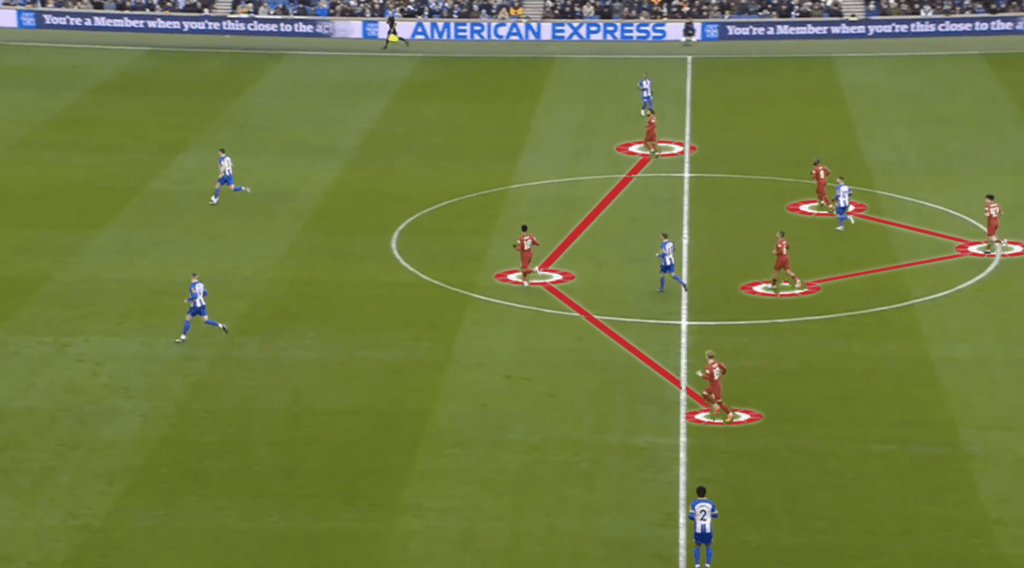
With compactness on his mind, Liverpool have adopted a mid-block (seen above) without the ball which can morph into a 4-4-2 in possession, with Naby Keita shuffling to the right to allow Mohamed Salah inside (seen below).
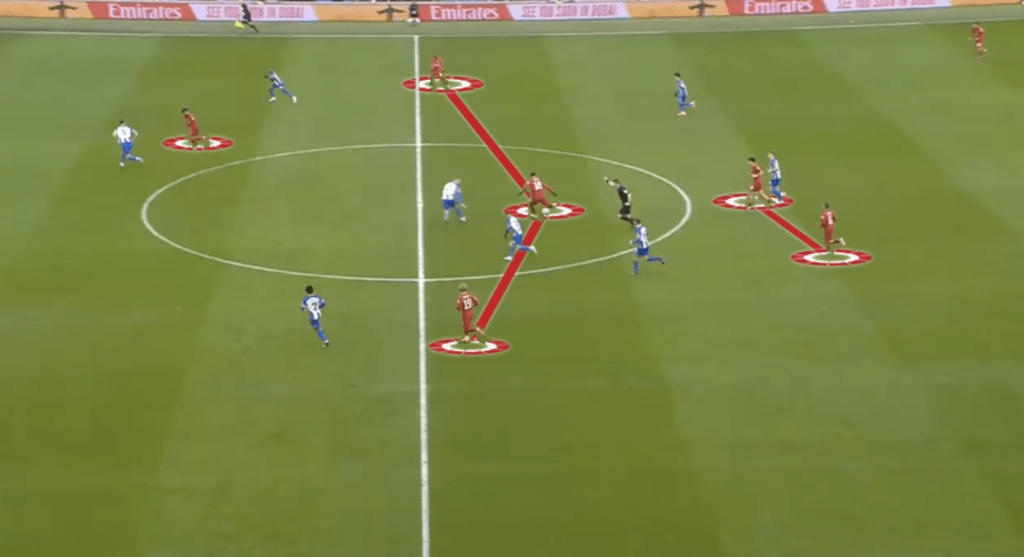
The general idea is to ensure there are bodies in central areas so that the defence has better protection.
Since this change, Liverpool have looked more defensively resilient in open play.
Set pieces have been problematic though.
Klopp has referenced the need for height in his team in the past. It was cited as one of the reasons why he didn’t give Takumi Minamino as many opportunities during the injury crisis in 2020-21.
With Stefan Bajčetić and Naby Keita in for Fabinho and Jordan Henderson, Liverpool are smaller. They also lack a physical presence in defence with Joe Gomez and Joel Matip starting in place of Virgil van Dijk and Ibrahima Konaté. In short, the Reds are smaller and not as dominant defensively. And this is being exploited by the opposition.
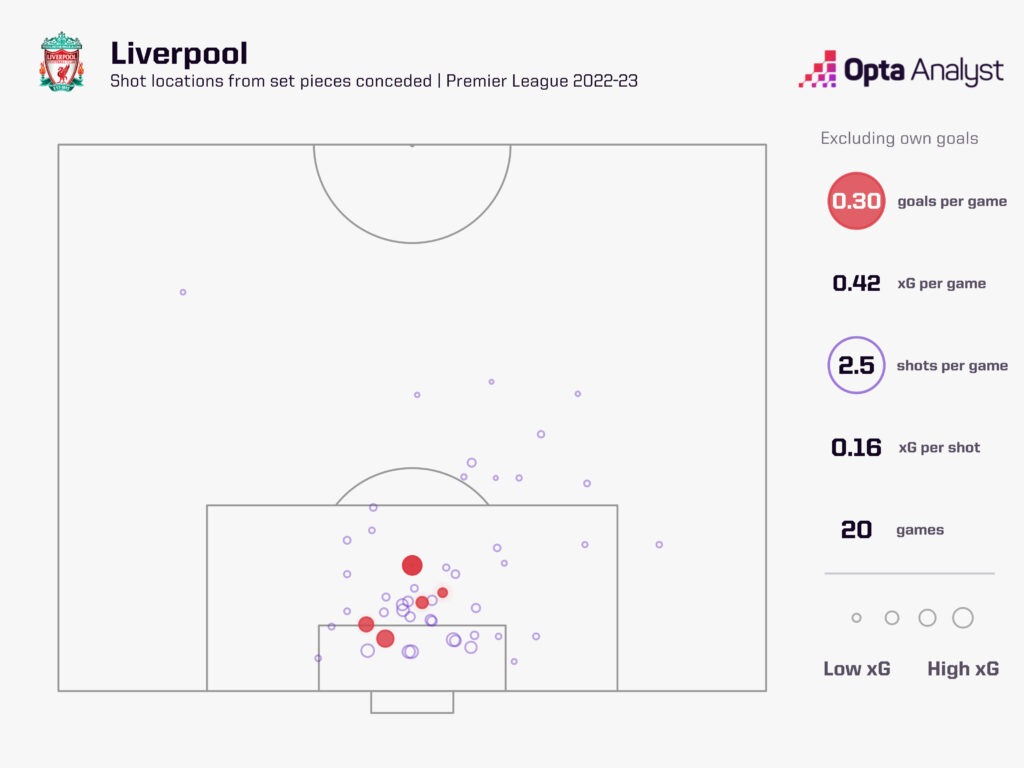
Last season, 0.17 of their xG conceded per 90 was via set pieces. This season, that figure has nearly doubled, jumping to 0.30. Both goals in the defeat to Brighton were in the aftermath of a set piece while Craig Dawson fired home the second goal for Wolves after chaos following a free-kick.
Of the goals conceded this season, 21% have been headers compared to the 17% of the previous campaign. Coincidentally, Liverpool’s non-penalty xG conceded via set pieces has also risen this season, up from 19.4% to 21.7% this time around. Only City (17.7%) conceded a lower percentage of set piece goals during the 2021-22 season but Klopp’s side now find themselves ranked seventh for this. What was once a strength is now not one.
The Reds have conceded a higher percentage of headed goals and set-piece goals.
In an attempt to shore things up, they have, literally, left themselves short and that is now being exposed. Liverpool are yet to strike a balance in how they attack which impacts the way they defend. Without this, it is impossible to control situations, moments or matches.
Enjoy this? Subscribe to our newsletter to receive five stories each Friday. It’s free. Also, follow us on Twitter.
